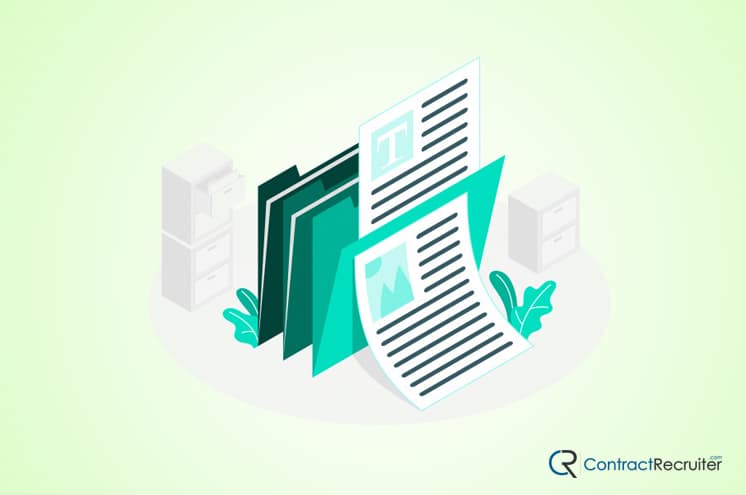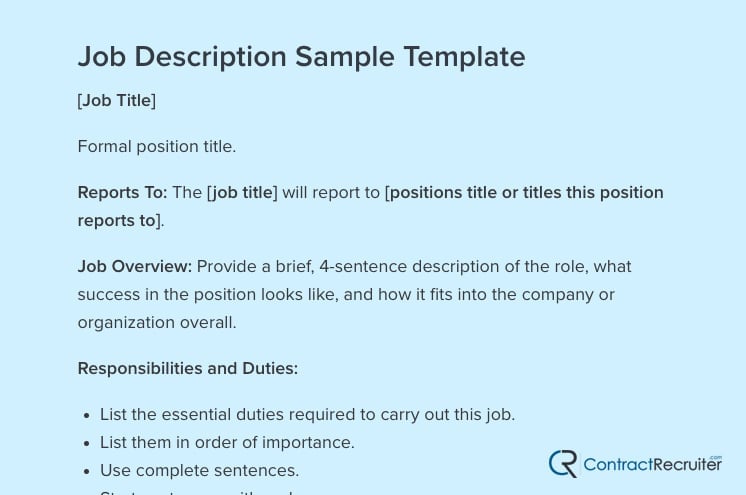A common piece of advice for job seekers is to make your resume stand out. So why shouldn’t the same be true of hiring managers? When you’re offering a new position, whether it’s to your careers portal, a job aggregator, through a recruiter, or anything in between, you want to stand out from the rest of the pack.
You want to attract the best candidates for any role, and that means making sure your job posting is the one they see and apply to first.
There’s a lot that goes into this, so strap in, we have a lot of ground to cover.
Create an Internal Job Description
Many people use “job description” and “job posting” as interchangeable terms. The truth is, they’re different documents. A job description is an internal document you use to explain the job. It’s a longer document than your job posting and is meant to ensure that everyone involved in your hiring process is on the same page about what they’re looking for.
Creating an internal job description document serves two purposes. First, as mentioned, it ensures that everyone is on the same page. Second, it allows department heads and managers to add their input to a document. Your HR team might not know heads or tails about Windows server administration or corporate networking, but they need to hire someone who does, so having key requirements as part of an internal reference document can be a valuable resource.
TalentLyft has a database of over 500 template job descriptions you can use as a starting point for many common roles. From there, discuss with your team leads and department managers to add specific information or knowledge to look for.
Create a Candidate Persona
Much like how sales teams and marketing teams create buyer personas, your hiring team should create a candidate persona. Your candidate persona should be a profile or overview of what the ideal person to fill your open role would look like. Ignore demographics here; you’re looking for experience levels, skills, desires, and other job-relevant attributes. Here’s a guide on how to create one.
(Example candidate persona courtesy of Beamery)
Your candidate persona informs how you write your job posting. Knowing something like whether you’re looking for a Type A or Type B person for a role can change how you’re writing the job posting, what benefits you’re promoting, and so on.
Optimize Individual Elements of the Listing
Each element of a job posting needs to be optimized to target the kinds of people you want applying for the job.
Here are the primary elements that you’ll want to focus on:
- Job Title: Make sure to list a title that is reflective of the role. Remember to choose something candidates will search for, so your post will be found. No one thinks of themselves as a “sales ninja”, so no one will be searching for ninja positions. Avoid the buzzwords at all costs. They’re grating, no one thinks of themselves in those terms, and they can often be degrading for the very people you’re trying to hire.
- Location: There’s not a lot to optimize in terms of location, but make sure you mention it, as well as whether or not the position can be remote or partially work-from-home.
- Responsibilities: A good job post should have a short-yet-robust list of job responsibilities, that gives a candidate a realistic idea of what they’ll be doing today. More on this later.
- Qualifications: A good job post should have a short-yet-robust list of qualifications, those experiences, skill levels, certs, and attributes that a candidate needs to succeed in the role. More on this later as well.
- About the Company: Even if you’re a national or globally-recognized company, your job posts should include a simple About section that sells who you are, what you’re working on, and what an employee will be doing in the big picture.
- Benefits: List your basic benefits and any specific benefits you can offer to a role, such as flexible hours, family leave, work from home, and training.
Every job post should finish up with instructions on how to apply, even if it may seem obvious. A dedicated call to action is always better than assuming your audience can read your mind.
Pick the Right Job Responsibilities
Every given role in a company is usually filled with day-to-day drudgery, with the occasional high-level project, a moment of crisis when something goes wrong, or a big debut moment such as a product launch or major conference presentation. Picking the right set of job responsibilities to sell the role is crucial.
You need to walk a narrow line. On one hand, you need to accurately portray the job you’re hiring for. If you entice a candidate with tales of exciting and unique development challenges, and they spend 90% of their days managing password resets and rebooting routers, they’re going to be dissatisfied. On the other hand, you need to sell the job; highly talented developers want unique challenges and problems to solve, so if they get the opportunity to do that, let them know.
Ilya Bodner has similar feelings on this:
“Honesty is the way to go. I see so many companies make inflated promises – something that turns off the highly qualified candidates, especially in sales/biz dev jobs.”
Your list of responsibilities should be realistic, relatively short, and exciting enough to sell the role. Remember; job seekers see hundreds of these lists, so you need to find unique selling points in your roles.
Narrow the Job Qualifications
The single biggest mistake companies make in writing job postings is writing down 100% of what the ideal candidate “needs” to succeed in the job.
Realistically, only about 60% of that is necessary for a new hire. The rest is either above-and-beyond skills that don’t come into play very often or can be worked around or skills that can be learned or trained on the job.
It’s true that many companies list extremely high qualifications and “settle” for the best of the most motivated applicants. Unfortunately, this practice can contribute to gender discrimination, as well as turning off candidates who would be better qualified but don’t feel like they can meet the full requirements list.
Pare down your qualifications list to just what is necessary to begin. Remember that your existing team can help train your new employee to bring them up to speed. Oh, and those certifications or experiences that only come into play once a year? You can work on getting them those as well.
Emphasize Job Perks
Part of selling your job posting is selling your workplace as a place where employees can build relationships, careers, and experiences.
You can attract more candidates (as well as better candidates) when you focus on the perks of working for your company.
Now, keep in mind that this means real perks. Having a foosball table in the break room isn’t a perk. Who even really likes foosball, anyway? The same goes for having a restaurant on campus, or open nerf wars in the cube farm, or any of the other nonsense that tech companies so often promote.
What kind of job perks attract the best candidates?
- Ongoing training funded by the company, including certs where relevant.
- The option to work partially or fully remote, or on a flexible schedule.
- Support for families with new children, including leave for fathers as well as mothers.
You can also include elements that indicate your company culture and values, such as company facilities to assist with alternative transportation to work, annual retreats (on the company dime) to see your products in action, or humanitarian outreach.
Make Your Posting Accessible
A surprising number of otherwise minor details combine to make a job posting accessible – or not – for many job seekers.
- Consider formatting. A job posting should have short paragraphs, simple headings, bulleted lists, and formatting to make salient details stand out. Every extraneous word gets in the way of your candidate’s desire to apply, especially on mobile devices. This leads us to our next point:
- Consider the viewport. Over half of all web traffic is performed on mobile devices today, and that includes job hunting. According to AIHR Digital, over 90% of modern-day job seekers use mobile devices to look for new jobs. While you can’t always control the mobile display of a job posting, you can make sure your text and images are all readable and to the point, and that your own careers page is mobile-optimized.
- Consider language. Not actual language – though that can be important as well, especially for bilingual roles – your writing style. Avoid jargon and buzzwords that can turn off candidates who want something more grounded. Avoid acronyms that may not be well-understood outside of your office.
Focus on what your candidates should know. Limit the amount of fluff in your posting and cover the most important details of the position.
Use Multimedia in Your Posting
Some of the best and most compelling job postings on the modern job market are more than just a text document made out of a template and slapped on hundreds of job sites. These job postings are multimedia presentations; they have the core text, of course, but they also include images, videos, infographics, and other media elements that assist with selling the role.
One thing to keep in mind is that, while multimedia is attractive to many people, it shouldn’t be crucial to the job listing. Make sure there are summaries, transcripts, and alt text for images to ensure accessibility for those who can’t properly consume multimedia.
Multimedia can be excellent for portraying company culture, job responsibilities, and company values in a compact place. Make use of it.
Keep Your Posting Updated
Matthew Podolsky, from Florida Law Advisors, recommends keeping your job posting up to date.
“I will update the job posting about once a week. Many employment advertising services will move the post to the top of their list and treat it as a new posting every time it is updated. This trick is very helpful but does not work with every employment service.”
In addition to bumping your posting to the top of the field, updating minor details allows you to essentially split test your list. If a particular set of benefits isn’t attracting the right candidates, try changing it. You can also change the plain language description, company profile, and requirements as you go.
Post a Salary Range
This is a contentious subject, and we don’t usually recommend it, but other people do.
Will Land from Accessory Export had a positive experience with it, saying:
“I know it sounds taboo, but we recently put out an ad to hire a director of marketing. The first ad we launched said ‘salary based on experience’ or something standard like that. Our applications were mediocre at best. Two weeks later, we launched the ad with the salary range, and we have had the best resumes and applications come in. Now we are trying to narrow down our favorites.”
Many companies today no longer list salary range, for some of the reasons we listed in our breakdown. That does mean, however, that listing salary is a way to make your job posting stand out. Whether it stands positively or negatively, well, that depends on the salary. You can also consider mentioning that you offer competitive pay without directly mentioning a range.
Break Away from Templates
There’s a temptation to use templates for just about everything in business. In some cases, it’s just fine, but many customer-facing or candidate-facing applications just fall flat when you’re using the same basic structure everyone else uses. You might not think anyone would notice, but the candidate who goes through hundreds of them will spot the patterns easily.
Derek Flanzraich says:
“Describe your job posting differently, and you’ll end up with candidates who are looking for something different. That means have fun with it. Speaking honestly and humorously about what the job entails is the best structure to communicate.”
Truly, the best advice you can follow for making a job posting stand out is not following all of the common advice. If you’re doing what everyone else is doing, you won’t stand out from the crowd.










